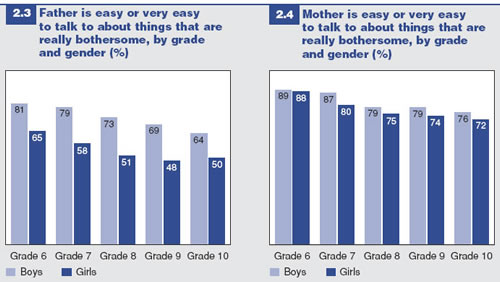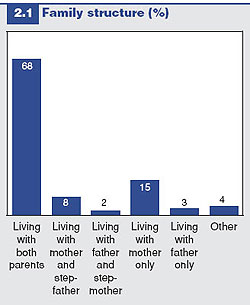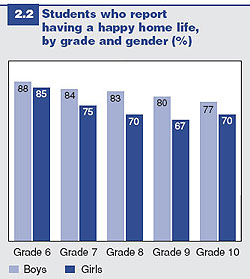Common menu bar links
Institutional links
Diseases & Conditions
Health & Safety
Research & Statistics
Agency Information
Search Box
Healthy settings for young people in Canada
Previous | Table of Contents | Next
2 Examining the Contexts for Young People’s Health
 In this chapter, we focus
on the important contexts,
or settings and conditions,
for young people’s health.
Students spend equally
important time in the
home, in school, and with
friends. In addition, their
socio-economic status
and social conditions
are believed to have an
increasing effect on
their health. These four
contexts are examined
separately here and then
are examined in relationship
to health behaviours
and health outcomes in
future chapters.
In this chapter, we focus
on the important contexts,
or settings and conditions,
for young people’s health.
Students spend equally
important time in the
home, in school, and with
friends. In addition, their
socio-economic status
and social conditions
are believed to have an
increasing effect on
their health. These four
contexts are examined
separately here and then
are examined in relationship
to health behaviours
and health outcomes in
future chapters.
HOME
by Frank Elgar
The importance of parents and home life
The family is the pre-eminent social system in a young person’s development. Although adolescence is typically a time when young people begin to challenge parental controls and to be influenced by their peers, the family can be an integral source of support through the school years. It is useful to examine the home setting, so that its relationship to health behaviours in school-aged Canadians may be better understood.
 How is the home setting measured by the HBSC study?
How is the home setting measured by the HBSC study?
In the 2006 cycle of the HBSC, we asked students about their family structure, general happiness at home, how well they could communicate with their parents, parental interest and encouragement regarding school, to what extent they felt understood and trusted by their parents, parental opinion and expectations, arguments with parents, and thoughts of leaving home.
What are we reporting on in this section?
We report on all these aspects of young people’s relationships with their parents, concluding with a description of two measures – living with both parents and a parent trust and communication scale – to be applied in our discussions of behaviours and outcomes in later chapters.
Data on parental interest and encouragement regarding school are presented in relation to the school setting discussed later in this chapter.
Parental communication, understanding, and trust

When asked how easy it is to talk to their parents, a higher proportion of students indicate that it is easier to confide in their mothers than their fathers (Figures 2.3 and 2.4). Overall, however, as students move from Grade 6 to Grade 10, fewer of them report finding it easy or very easy to talk to either parent. Significantly fewer girls than boys report finding it easy to talk to their fathers.

Gender differences are also found in young people’s perceptions of parental understanding and trust. As shown in Figures 2.5 and 2.6, more boys than girls report being understood by their parents and trusted by their parents.


